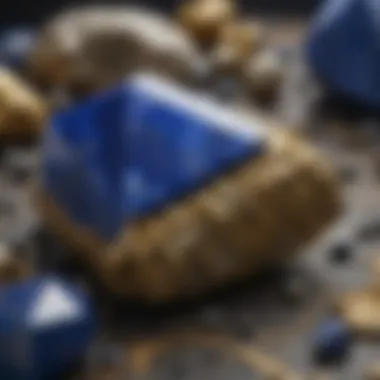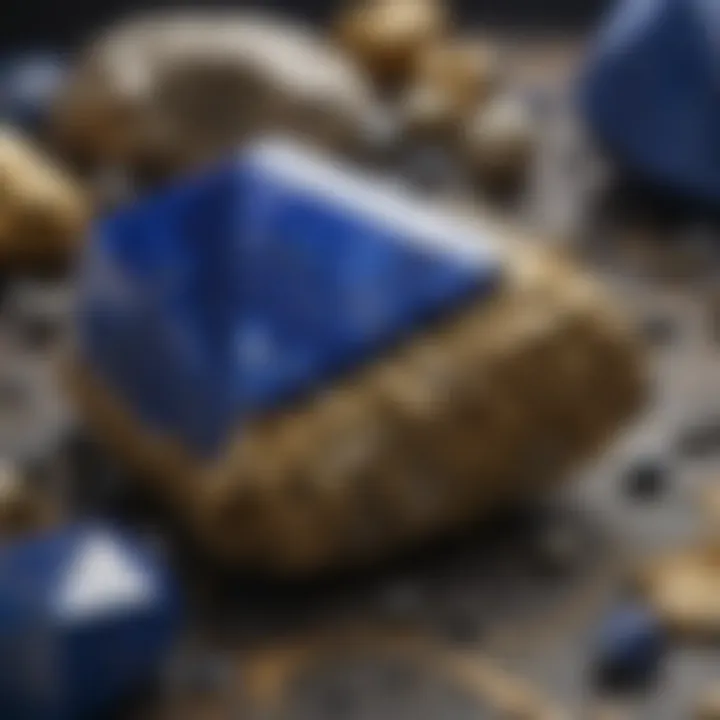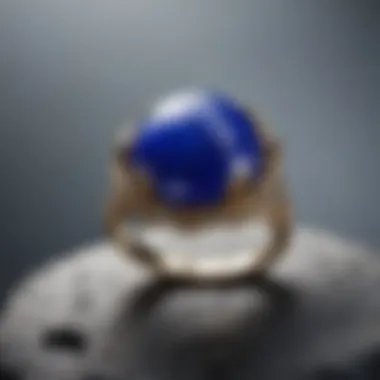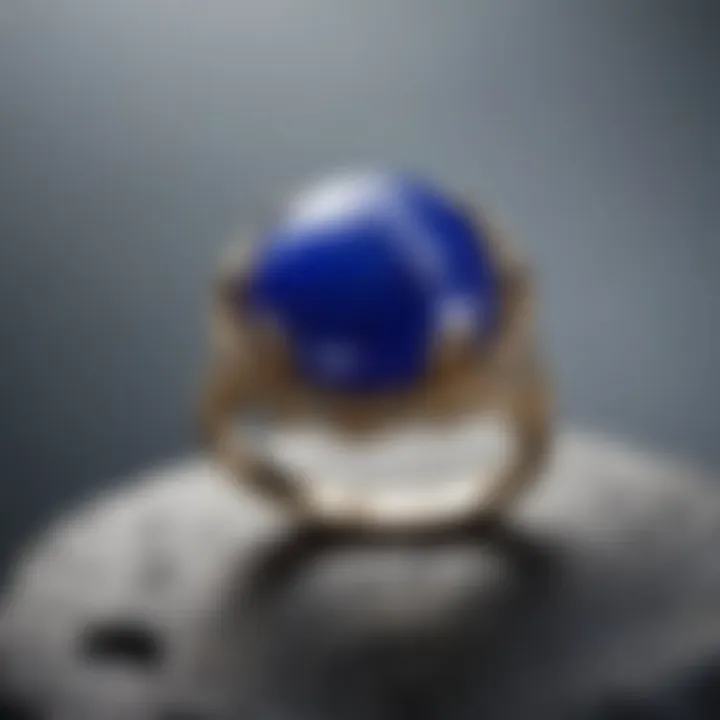The Lapis Gem: Unveiling Its Timeless Allure


Intro
Lapis lazuli has enthralled individuals across various cultures and time periods. Its rich azure hue and unique golden flecks have made it not just a gem, but also a symbol of wealth and prestige. This article uncovers the layers of significance behind lapis lazuli, examining its formation, historical relevance, and contemporary applications.
History and Origins
Overview of Collectibles, Rocks, and Fossils
Lapis lazuli is classified as a metamorphic rock, primarily composed of lazurite, along with other minerals such as calcite and pyrite. This combination contributes to its distinctive appearance. As collectors often seek lapis lazuli, they consider its rarity and the regions in which it is found. The most significant deposits of this stunning stone originate from Afghanistan, particularly in the Badakhshan province.
Historically, lapis lazuli was traded along ancient routes, establishing its value. Collectors often look for pieces that include traces of pyrite, which adds a sparkle and enhances the gem's visual appeal.
Historical Significance and Cultural Impact
Lapis lazuli holds a notable place in history. Ancient Egyptians prized it for its vivid color and used it extensively in jewelry and burial artifacts. It was often ground into powder for cosmetic purposes, illustrating its importance in daily life and spiritual practices. The stone was also associated with royalty and deities, making it an integral part of their beliefs.
In Mesopotamia, lapis lazuli was used to craft seals and amulets, showcasing its cultural significance.
"Throughout history, lapis lazuli has been regarded as a powerful symbol of protection, wisdom, and truth."
The stone's role transcends mere ornamentation. In the Renaissance period, it was revered by artists such as Michelangelo, who utilized lapis lazuli's pigment to create vivid blue paint. This historical context elevates the gem beyond mere aesthetic appeal.
Identification and Classification
Guide to Identifying Rocks and Fossils
Correctly identifying lapis lazuli among other gems is essential for collectors. The first step involves observing its color. Genuine lapis lazuli typically features a deep blue hue, with variations that may include flecks and veins of gold.
Here are some key identifiers:
- Color: Deep blue, with possible gold (pyrite) flecks.
- Texture: Smooth and sometimes waxy to the touch.
- Hardness: Ranges from 5 to 5.5 on the Mohs scale, which helps differentiate it from harder stones, such as sapphires.
Common Types and Variations
Within the realm of lapis lazuli, several types can be classified based on their origin and characteristics:
- Afghan Lapis: Most sought after, known for its intense color and high pyrite content.
- Chilean Lapis: Slightly lighter in hue, this variety is often more abundant.
- Russian Lapis: Recognized for its darker shades, often containing more calcite.
Each type varies in appearance and value, presenting unique opportunities for collectors to expand their collections. Understanding these differences can enhance the appreciation of lapis lazuli as a collectible gem.
Understanding Lapis Lazuli
Lapis lazuli is not just any gemstone. It is a rich, deep blue stone that has captivated cultures around the globe for thousands of years. Understanding lapis lazuli means exploring its significance, composition, and geological formation. This knowledge provides clarity for collectors and enthusiasts who appreciate its beauty, history, and unique qualities.
Definition and Composition
Lapis lazuli is defined as a metamorphic rock that consists primarily of lazurite, along with varying amounts of calcite, pyrite, and other minerals. These components give the stone its distinctive appearance, characterized by vibrant blue hues punctuated by golden specks of pyrite and white streaks from calcite. When used in fine jewelry or ornaments, lapis lazuli often retains a natural, unpolished look, emphasizing its organic origins.
The composition of lapis lazuli can reveal a lot about its origin and quality. The presence of lazurite is essential, as this mineral is largely responsible for the stone's intense color. While some stones may appear predominantly blue, others can exhibit green and violet hues, indicating the presence of other minerals in variable quantities. The overall quality of lapis lazuli is often determined by its color saturation, which affects its desirability in the market.
Geological Formation
The geological formation of lapis lazuli originates under specific conditions that occur in high-pressure environments. Most notably, the significant deposits of lapis lazuli are found in geological formations created through regional metamorphism. This process transforms original materials under extreme heat and pressure, a phenomenon that can occur over millions of years.
Lapis lazuli is primarily sourced from the Badakhshan province in Afghanistan, which is known for its ancient mining activities. Here, the stone is found within marble deposits, which have formed through the alteration of sedimentary rocks. The rich blue color of the lapis lazuli reflects the depth of the conditions under which it formed. Other notable sources include regions in Chile and Russia, where unique geological conditions allow similar formations to occur.
Understanding lapis lazuli begins with recognizing these defining characteristics and origins. With a brief insight into its composition and geological context, enthusiasts and collectors can appreciate the nuances of this timeless gem more profoundly.
Historical Significance of Lapis Lazuli
Lapis lazuli has a profound historical significance that spans several ancient civilizations. This stone has not only served as a precious material for decorative arts but also played an intricate role in cultural and spiritual practices. Understanding this context is essential when studying lapis lazuli because it reveals the gem's multidimensional appeal across time. Its unique blue coloration and rarity contributed to its desirability, making it a symbol of status and power. This section will explore the contributions of ancient civilizations to the significance of lapis lazuli.
Ancient Civilizations
Sumerians
The Sumerians were among the first to utilize lapis lazuli extensively. They were known for their sophisticated artistry and craftsmanship. They created intricate jewelry and seals using this gem, which signified wealth and importance in their society. The Sumerians also viewed lapis lazuli as a heavenly stone, connecting their rulers to the divine. This belief made lapis lazuli a popular choice for inscribing names and seals of authority. Its vibrant blue hue was distinct and unmatched by other materials available at the time, enhancing its significance.


Egyptians
The Egyptians revered lapis lazuli, integrating it into their religious and burial practices. It adorned everything from the tombs of pharaohs to sacred amulets, believed to offer protection and guidance in the afterlife. The unique shade of blue also symbolized the sky and the heavens, connecting them to the gods. Moreover, lapis lazuli was ground into powder to create a pigment used in wall paintings and cosmetics, underscoring its versatility and importance in artistic expressions. Its unavailability in the region made it an object of desire, often traded from distant lands, further emphasizing its high value.
Greeks
For the Greeks, lapis lazuli signified beauty and luxury. They used this gem in jewelry and decorative objects, showcasing their artistry and connection to opulence. The Greeks associated lapis lazuli with the heavens, elevating its status as a precious stone. This symbolic significance lent it a role in various mythological tales, where it was often linked to the divine. The Greeks appreciated its rarity and beauty, making it a sought-after material in trade and a staple in their cultural practices.
Cultural Relevance
Symbolism
Lapis lazuli has rich symbolic meanings across different cultures. It often represents wisdom, truth, and enlightenment. In various contexts, it has been linked with celestial themes, connecting wearers to higher realms. The stone's deep blue color serves as a reminder of the night sky and its mysteries, which makes it appealing for spiritual and philosophical pursuits. This symbolism has ensured that lapis lazuli remains relevant in modern times, as people continue to seek its deeper meanings.
Artistic Use
The artistic use of lapis lazuli spans centuries. It has been used in mosaics, carvings, and paintings. The quality of lapis lazuli allowed artisans to create stunning visuals that highlight its unique properties. While it remains a prized material, its uses in art emphasize the importance of creativity in expressing cultural identity. The challenge lies in balancing modern artistic practices with respect for its historical significance, as contemporary artists often explore new ways to utilize lapis lazuli.
Spiritual Significance
Many cultures attribute spiritual properties to lapis lazuli. It is often seen as a stone of protection and enlightenment in various spiritual practices. The belief in lapis lazuli's power to enhance intuition and inner wisdom makes it valuable to spiritual seekers. This aspect has allowed its relevance to transcend time, as it remains ingrained in holistic practices. However, care must be taken to separate historical interpretations from modern misconceptions surrounding its powers, maintaining respect for its indigenous roots.
Physical Properties of Lapis Lazuli
The physical properties of lapis lazuli are vital in understanding its identity as a gem. These properties not only define the stone's aesthetics but also determine its usability and desirability for collectors. Characteristics, such as color variations, hardness, and luster, come together to create a unique profile. This understanding helps enthusiasts and scholars better appreciate lapis lazuli, allowing for informed valuation and care.
Color Variations
Lapis lazuli is renowned for its striking blue hues. The most prized lapis has a deep, uniform blue color, often interspersed with flecks of gold from the mineral pyrite. However, this gem can span a diverse color spectrum ranging from vibrant royal blue to lighter shades, sometimes leaning towards greenish or grayish tones.
The intensity of color is significantly influenced by the mineral composition present. Higher concentrations of lazurite result in richer blues. The presence of calcite can create white streaks, while the presence of pyrite adds metallic flecks. Each variation contributes to the unique charm of lapis lazuli, making every piece distinct and collectible.
Hardness and Durability
In terms of hardness, lapis lazuli measures between 5 and 5.5 on the Mohs scale. This places it at a moderate level of hardness. While it is more durable than many softer stones, it is still prone to scratching and damage if subjected to rough treatment. Thus, careful handling is advisable, especially in jewelry applications.
Durability can be enhanced by the type of jewelry setting chosen. For instance, protective encasements help guard against everyday wear. Understanding lapis lazuli's hardness allows collectors to better assess its longevity and employ appropriate care techniques to preserve its beauty.
Luster and Texture
The luster of lapis lazuli is typically described as vitreous to dull, reflecting light in a subtle manner that underscores its natural beauty. The absence of a high sheen gives it a more understated elegance compared to other gemstones. Its texture varies depending on how the stone is polished. A well-polished surface can showcase the rich color while revealing underlying patterns. Conversely, rough or unpolished pieces present an earthier feel, appealing to a different aesthetic within the collector community.
Mining and Sources of Lapis Lazuli
The mining and sources of lapis lazuli are crucial to understanding its significance and value. This section explores the geographic locations of notable lapis lazuli deposits, as well as the extraction methods used to obtain this striking blue gemstone.
Geographic Locations
Afghanistan
Afghanistan is renowned as the primary source of lapis lazuli, particularly from the Badakhshan province. The high-quality deposits found here have been mined for over 6,000 years, making it a historic site for this gem. The deep blue color, often interspersed with gold flecks of pyrite, makes Afghan lapis particularly desirable.
The unique geology of Badakhshan features mountainous terrain, which can make mining challenging. However, this also means that the lapis lazuli found here tends to be of very high quality. The cultural heritage surrounding its extraction adds significance, as many local artisans still employ traditional mining practices.
Overall, Afghanistan's lapis lazuli is valued for its intense hue and historical prestige, making it a cornerstone for collectors.
Chile
Chile has emerged as a secondary source of lapis lazuli. The deposits found in the Andes Mountains, mainly near Ovalle, produce a different quality gemstone that is still appreciated in the market. Chilean lapis is characterized by a lighter blue color, often with less gold pyrite than its Afghan counterpart. While it might not carry the same historical weight or vibrant hue, it is still a commendable alternative.
The accessibility of these mines has made extraction more straightforward compared to Afghanistan, with modern techniques often utilized in the process. This means that production can be more consistent, making Chilean lapis a more reliable option for jewelers and collectors alike.
Russia
Russia is another region where lapis lazuli can be found, particularly in the Ural Mountains. The quality of Russian lapis varies widely, and while it may not match the intense hues of Afghan lapis, it does present a unique charm. Russian lapis can have more varied color ranges, which can include shades of green and violet alongside blue.
However, the mining of lapis lazuli in Russia is less prominent compared to Afghanistan and Chile, leading to lower recognition in the global market. Nevertheless, it provides a valuable alternative, especially for those interested in a more diverse assortment of color and texture.
Extraction Methods


The extraction methods for lapis lazuli depend largely on the geographical location of the mines. In Afghanistan, traditional mining methods are often applied. Artisans carefully extract the stones by hand, a process that allows for close attention to quality but can be labor-intensive and dangerous. Safety conditions are often a concern due to the mountainous terrain.
In contrast, Chilean sources might utilize more modern techniques, including machinery to facilitate the removal of lapis lazuli from the earth. This can lead to more efficient production but may also impact the environmental integrity of the mining sites.
Regardless of the location, understanding these methods is important for collectors and enthusiasts. Knowledge of where and how lapis lazuli is sourced can provide insight into its value and authenticity, which is vital in today’s market.
Valuing Lapis Lazuli
Valuing lapis lazuli is vital for collectors, artisans, and enthusiasts. This gem has significant historical, aesthetic, and monetary worth. Understanding its evaluation allows stakeholders to make informed choices in purchases and investments. This section will explore the key factors that determine the value of lapis lazuli, including quality, size, and rarity. Each aspect plays a crucial role in grasping the overall market dynamics surrounding this alluring stone.
Factors Influencing Value
Quality
Quality is perhaps the most critical aspect of valuing lapis lazuli. The gem's visual appeal is directly tied to its primary quality indicators: color saturation, presence of impurities, and texture. High-quality lapis lazuli exhibits a deep, royal blue hue with minimal white calcite inclusions and golden pyrite flecks. This rich color is highly sought after.
Quality directly impacts the desirability of the stone. For instance, a piece with an intense blue shade is generally considered more exquisite and valuable. Moreover, the unique feature of lapis lazuli's color variation can dictate its suitability for specific uses, such as upscale jewelry compared to more casual applications. Thus, investing in high-quality lapis lazuli can prove advantageous due to its lasting appeal.
Size
Size plays an important role in how lapis lazuli is valued. Larger pieces naturally command higher prices. Bigger specimens offer more opportunities for customization in jewelry making and other decorative arts.
The key characteristic here is that larger stones often contain more material, which can lead to higher market value. Collectors tend to favor substantial lapis lazuli pieces because they are visually striking. However, practical concerns also arise with larger stones, such as crafting and wearability in jewelry. Thus, size is a double-edged sword; while it can elevate value, it may also present challenges in specific applications.
Rarity
Rarity significantly affects the valuation of lapis lazuli. The stone's primary source is Afghanistan, where the best quality is mined. When deposits run low or if a gemstone is hard to find, its value tends to increase. Collectors often seek rare types and unusual specimens.
Rarity adds a layer of intrigue to a piece, making it more appealing in the eyes of buyers. The unique feature of rarity often results in high demand, which can elevate prices quickly. For instance, limited-edition pieces or those with distinct color characteristics are often coveted, making them valuable additions to any collection.
Market Trends
The market for lapis lazuli is dynamic, subject to shifts in both consumer preferences and global economic conditions. Currently, there is a resurgence of interest in natural gemstones, placing lapis lazuli in a favorable position among jewelers and collectors. Many are seeking ethically sourced stones, which also affects their value in the market. Collectors must stay informed regarding these trends to make calculated purchases.
By understanding these factors—quality, size, and rarity—collectors can appreciate the intricate dynamics that define the value of lapis lazuli.
"The true worth of lapis lazuli lies not only in its price but in the stories it tells and the connections it fosters."
Choosing the right piece requires not just knowledge but also an appreciation for this gem's unique history and cultural significance.
Craftsmanship and Uses
Lapis lazuli is not merely a gem; it is a canvas for artisans and a symbol of beauty across cultures. Its unique properties and stunning deep blue color have inspired artistry for centuries. Understanding craftsmanship and uses provides insight into the true value of this remarkable stone.
Jewelry Making
The art of jewelry making with lapis lazuli is a cherished tradition. Craftsmen cut, shape, and polish this brilliant stone into various forms. Jewelry pieces such as necklaces, bracelets, and rings showcase the stone's rich hue. Lapis lazuli holds cultural significance in many societies. This gem is often associated with wisdom and truth, making it a popular choice for meaningful gifts.
Working with lapis lazuli requires skill. The stone's hardness is about 5 to 6 on the Mohs scale, which means it can be challenging to carve but worth the effort for the beauty it yields. Jewelers often combine lapis lazuli with metals like gold or silver to enhance its aesthetic appeal. The contrast between the blue stone and metallic tones creates a stunning visual dynamic. This mixture of gold and lapis lazuli predates modern times, evident in ancient Egyptian jewelry that often featured the stone.
"Jewelry making with lapis lazuli is not just about beauty; it's about the stories and traditions intertwined with each piece."
Moreover, lapis lazuli jewelry can have therapeutic benefits. Believers in crystal healing suggest that wearing this gem promotes serenity and boosts self-awareness. Jewelers capitalize on this belief, marketing lapis lazuli items not just as adornments but as tools for personal growth. Consequently, lapis lazuli remains a staple in contemporary jewelry, attracting both collectors and casual wearers alike.
Decorative Arts
Beyond jewelry, lapis lazuli finds profound applications in decorative arts. This stone is used in items like sculptures, vases, and inlays for furniture. Its rich blue color brings life to any object it adorns.
The process of using lapis lazuli in decorative arts often involves intricate design. Artisans carefully source raw lapis lazuli, which is then ground into a fine powder for use in paints and dyes. This method has historical roots, as lapis lazuli was traditionally used to create vibrant pigments in frescoes and manuscripts. The color was prized for its intensity and durability, making it a favorite among artists.
In modern contexts, lapis lazuli's allure is reflected in interior design. Homeowners use lapis lazuli-inlaid furniture as statement pieces, adding sophistication to living spaces. Accessories like coasters or picture frames made from this stone enhance decor while serving functional purposes.
The craftsmanship surrounding lapis lazuli underscores its versatility. Item crafted with lapis lazuli can transcend mere decoration, becoming symbols of artistry, heritage, and status. Thus, lapis lazuli's role in craft continues to evolve while maintaining its historical integrity.
Care and Maintenance of Lapis Lazuli
Caring for lapis lazuli is essential to preserve its beauty and longevity. This gem, with its deep blue hues and golden flecks, requires specific maintenance practices to ensure it remains in pristine condition. Understanding the importance of care can protect your investment and keep it looking vibrant. Proper care allows you to enjoy the unique visual characteristics of lapis lazuli for years.


Cleaning Techniques
Cleaning lapis lazuli requires a gentle approach. Avoid harsh chemicals or abrasive materials that can damage its surface. The best method is to use lukewarm water and a soft cloth. Here are some steps to follow:
- Preparation: Gather a bowl of lukewarm water.
- Cloth Selection: Use a soft, lint-free cloth. Microfiber cloths are ideal.
- Cleaning: Dampen the cloth with the water, then gently wipe the surface of the lapis lazuli. Take care not to soak the gem, as it is porous and can absorb liquids.
- Drying: Use a dry part of the cloth to remove any moisture.
Avoid cleaning lapis lazuli with steam or ultrasonic cleaners, as these can harm its finish and structural integrity. By following these simple steps, you can keep your lapis lazuli free from dirt and residues, preserving its natural allure.
Storage Recommendations
Proper storage is critical to maintaining the condition of lapis lazuli. Exposure to harsh conditions can lead to scratches and other damage. Here are some guidelines for effective storage:
- Individual Storage: Store each piece of lapis lazuli separately to prevent scratching.
- Soft Pouches: Use soft pouches made of fabric to protect the gems from environmental factors.
- Temperature Control: Keep your storage area cool and dry. Extreme temperature changes can affect the gem's quality.
- Avoid Direct Sunlight: Prolonged exposure to sunlight can fade the color of lapis lazuli. Store it in a shaded area or in a box.
By following these storage tips, you can ensure that your lapis lazuli pieces remain safe and retain their beauty over time.
Lapis Lazuli in Contemporary Culture
Lapis lazuli has transformed its significance over the ages and now holds a unique place in contemporary culture. This section examines how this ancient gemstone continues to influence modern society, particularly in the realms of jewelry and fashion. The revival of interest in lapis lazuli speaks volumes about its intrinsic qualities and the aesthetic it offers to current trends.
Modern Jewelry Trends
In recent years, lapis lazuli has regained favor among jewelers and consumers alike. Its deep blue hue and flecks of gold create striking pieces that stand out in modern jewelry collections. Designers incorporate lapis lazuli into necklaces, rings, and earrings.
Several trends are steering the use of lapis lazuli in modern jewelry:
- Minimalist Designs: Lapis is often set in simple, sleek, and minimalist forms, enhancing its bold color while maintaining a sophisticated look.
- Layering Styles: Lapis lazuli works well in layered jewelry looks. Consumers combine it with other materials, such as gold or silver, for a more textured appearance.
- Healing Properties: There is a growing interest in gemstones believed to have metaphysical properties. Lapis lazuli is often attributed with promoting wisdom and self-awareness, adding value beyond its physical beauty.
As shoppers increasingly seek unique, gemstone-rich jewelry, lapis lazuli holds a special attraction that appeals to both collectors and those simply wishing to adorn themselves with something distinct.
Role in Fashion
The role of lapis lazuli extends beyond jewelry; it plays a significant part in the broader fashion industry. Fashion designers are using lapis lazuli in clothing design and accessories. This gemstone's color pairs harmoniously with various palettes, making it versatile.
Considerations in contemporary fashion include:
- Textile Incorporation: Fabrics dyed with shades inspired by lapis lazuli resonate in high-end fashion. These textiles evoke a sense of luxury.
- Accessories and Home Decor: Beyond personal accessories, lapis lazuli's impact is seen in home decor. Items like decorative bowls, coasters, and wall art integrate this stone.
- Sustainable Fashion Influence: The demand for ethically sourced materials influences designers to incorporate lapis lazuli, as it is often mined under strict environmental guidelines.
As lapis lazuli continues to inspire modern culture, it remains a symbol of beauty, creativity, and sustainability in the fashion world.
In summary, the contemporary relevance of lapis lazuli is palpable in both jewelry and fashion. Its lustrous appearance, combined with the allure of historical significance, ensures that this gemstone will retain its charm and importance for years to come.
Myths and Misconceptions
Understanding the myths and misconceptions surrounding lapis lazuli is essential for collectors and enthusiasts alike. These notions can obscure the true value, history, and significance of this exquisite gemstone. Accurate knowledge can enhance appreciation and respect for lapis lazuli, guiding people to make informed decisions. This section aims to clarify common errors and misunderstandings, fostering a deeper understanding of this ancient gem.
Common Myths Debunked
Many myths circulate about lapis lazuli. One pervasive myth is that all lapis lazuli is the same in quality and appearance. This is incorrect. The stone comes in various qualities, influenced by its mineral composition and origin. The best specimens, often from Afghanistan, exhibit a rich blue color with minimal veining. On the other hand, lower quality stones might appear dull or mottled, comprising more calcite and pyrite inclusions that diminish their aesthetic appeal.
Another common myth concerns the so-called "healing properties" of lapis lazuli. While proponents claim it can enhance intellectual ability and emotional healing, scientific evidence supporting these assertions is lacking. While the stone may hold sentimental or aesthetic value, its functionality remains tied to folklore rather than empirical proof. Thus, appreciating lapis lazuli should focus on its beauty, artistry, and historical implications rather than unproven claims of healing.
Cultural Misunderstandings
Cultural misunderstandings about lapis lazuli often arise from its historical journey. In ancient Egypt, it was exclusive to royalty, believed to contain mystical powers. This led to the perception that lapis lazuli was only for the elite. In reality, lapis lazuli was also utilized by craftsmen and artisans throughout various cultures, indicating a broader appeal than just the upper class.
Moreover, the widespread association of lapis lazuli with negative connotations should be addressed. Some cultures view it as a stone of bad luck or misfortune due to its deep ties to war and conflict throughout history. It is crucial to recognize that these perceptions are cultural and vary widely across different regions. Understanding the historical context can dismantle these misconceptions and promote a more nuanced view of the stone.
In summary, clarifying myths and challenging cultural misunderstandings provides a more accurate portrayal of lapis lazuli. Such insights allow collectors and enthusiasts to appreciate the stone based on its true merits, facilitating a deeper connection to its rich history and ongoing cultural relevance.
Finale: The Enduring Allure of Lapis Lazuli
Lapis lazuli remains a symbol of beauty and significance through various epochs and cultures. Its richness in color and complexity in origin contribute to its appeal, making it an important subject of study for collectors, hobbyists, and scholars alike.
From its geological formation in the rugged mountains of Afghanistan to its profound historical connections with ancient civilizations, lapis lazuli captivates with its story. The gem has adorned the necks of rulers and inspired artists, merging its aesthetic qualities with realms of spirituality and cultural identity.
The key elements to consider include:
- Symbolism: Lapis lazuli carries meanings across different cultures, often representing wisdom and truth.
- Cultural Legacy: Its historical significance enhances its value, reflecting a shared human heritage.
- Modern Relevance: Today, this gemstone finds its place not only in traditional jewelry but also in contemporary art and fashion, blending the past with modernity.
Investing in lapis lazuli is not merely about acquiring a piece of jewelry. It is about owning a fragment of history, a conversation starter that reveals the human story behind the stone. The increasing interest in natural gemstones reaffirms the lasting allure of lapis lazuli. As collectors seek authenticity and uniqueness, lapis lazuli stands out as both a precious object and a profound symbol.
"The enduring allure of lapis lazuli is rooted in its blend of beauty and meaning, making it as relevant today as it was millennia ago."
The continued exploration of lapis lazuli's cultural and personal significance will likely leave an indelible mark on future generations. Understanding its allure may lead to greater appreciation not just for the gemstone itself, but for the historical contexts in which it was cherished. The journey of lapis lazuli extends beyond its physical form, creating a narrative that is both timeless and relevant.



